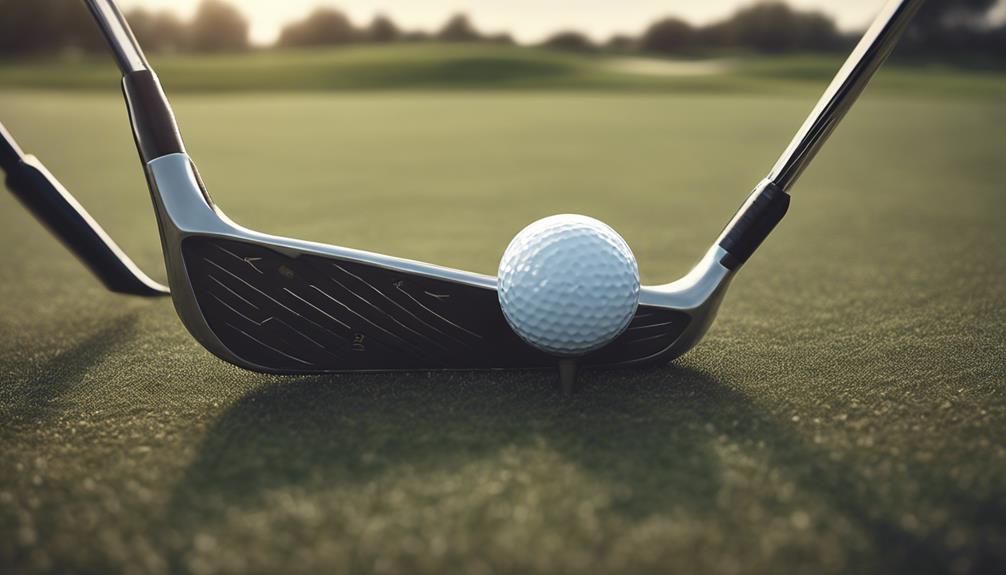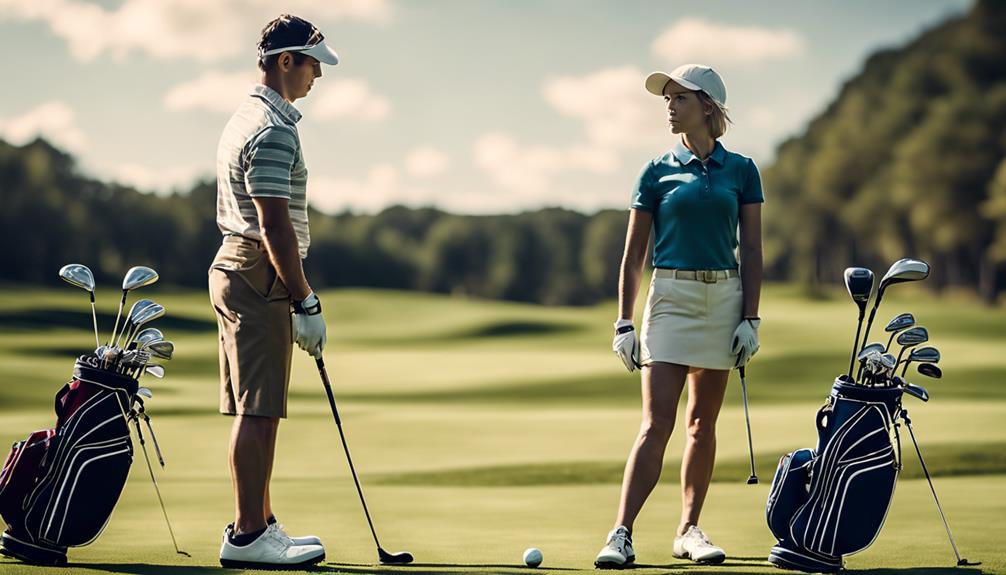- 7 Top Flite Golf Clubs XL for Improved Performance - September 28, 2024
- Top Flite Golf Clubs: Top 5 Reasons to Choose Them - September 28, 2024
- Top 3 Golf Club Fitters for a Perfect Swing - September 28, 2024
You'll likely be surprised to learn that men's golf clubs are typically one inch longer than women's clubs, and that the ideal club length is approximately 48.9% of your height, as determined by the wrist-to-floor measurement. Club length directly affects swing efficiency and overall performance, so it's essential to get it right. Factors like lie angle, swing style, and individual proportions come into play, making a one-size-fits-all approach impossible. As you explore the complexities of club length, you'll uncover the importance of customization and how it can elevate your game. There's more to discover about finding the perfect fit.
Key Takeaways
- Club lengths vary and are tailored to individual needs, with men's clubs typically 1' longer than women's clubs.
- Height-based charts are used to recommend club length, but may not always be accurate due to individual proportions.
- The wrist-to-floor measurement is a more accurate way to determine ideal club length, which is approximately 48.9% of one's height.
- Lie angle affects club length, with a 1° increase raising the butt end approximately 1/3' off the ground.
- Customized fitting is necessary to achieve the perfect club length, considering factors such as swing style, arm length, and physical characteristics.
Understanding Golf Club Length
When selecting golf clubs, understanding the importance of club length is vital, as it directly affects your swing's efficiency and overall performance.
You'll notice that length irons vary, and it's not just about the standard length. Club lengths are tailored to individual needs, and getting it right is imperative. For instance, the average woman's height in the U.S. is 5'5', which affects the recommended length. Men's clubs are typically 1' longer than women's clubs.
During a Club Fitting, the wrist-to-floor measurement is often used to recommend the ideal length. This involves standing with your feet together, arms relaxed, and measuring the distance from your wrist to the floor.
On average, this measurement is 48.9% of your height. However, individual proportions must be taken into account, as height-based charts may not always be accurate.
Additionally, the lie angle of your club affects the length, with a 1° increase raising the butt end approximately 1/3' off the ground.
Measuring for the Right Fit
You'll typically start measuring for the right fit by determining your wrist-to-floor measurement, a key step in finding the ideal club length that suits your unique swing. This measurement, which is approximately 48.9% of your height, will indicate the right club length for you.
When you get your measurement, you can use height-based charts to determine the right club length, considering proportions such as 1' shorter or longer for every 5-6' of height differential.
Keep in mind that junior club lengths don't follow the same 6:1 formula as adult clubs, requiring a different measurement approach.
A club fitter can help you determine the perfect fit, taking into account your swing style and other factors that can affect your game.
If you're looking for a custom club, your wrist-to-floor measurement will be essential in creating a club that's tailored to your needs, ensuring you get the most out of your game.
The Importance of Lie Angle

Your club's lie angle plays a critical role in determining its overall length, as it forms a triangle with the vertical distance from the grip to the ground and the horizontal distance from the heel to the grip.
By altering the lie angle, the manufacturer can theoretically change the vertical length, and for each 1° increase, the butt end raises approximately 1/3' off the ground with the center of the sole touching the ground.
This means that lie angle affects the length of the club, and manufacturers may opt to change the lie angle instead of making the club longer to accommodate taller individuals or those with high WTF measurements.
Notably, a standard weight 5-iron (256g) with different lengths and lie angles can produce the same situation where the center of the sole is touching the ground and the butt end is nearly the same height off the ground.
This highlights the significance of considering lie angle when fitting for the right club length, as it can greatly impact your overall swing and game performance.
Swingweight and Club Length
Golfers seeking to optimize their swing performance must consider the intricate relationship between swingweight and club length, as subtle variations in these factors can profoundly impact their overall game.
When it comes to iron sets, a standard weight 5-iron (256g) can produce the same swingweight with different lengths and lie angles, highlighting the complex relationship between these three factors.
A 1° increase in lie angle raises the butt end approximately 1/3' off the ground, affecting club length and swingweight.
The lie angle also affects club length, as shown in the triangle formed by the club length, vertical distance from the grip to the ground, and horizontal distance from the heel to the butt end.
Swingweight is critical in determining the correct club length and lie, as different combinations can produce the same situation where the center of the sole touches the ground and the butt end is the same height off the ground.
Controlling swingweight by manipulating the lie is often easier than adding/removing weight from the head, making lie angle a vital consideration in club fitting and customization.
Unique Fitting Situations

Unique physical characteristics, such as arm length and wrist-to-floor (WTF) measurements, can substantially impact the fitting process, requiring customized club lengths and lie angles to optimize swing performance.
You may need different lengths based on averages, as Mike's case demonstrates. His arm length, equivalent to a normal person's elbow position, required a partial set with longer clubs, including a driver 2 inches longer than normal and a 5-iron 5.5 inches longer than average.
His WTF measurement of 43, equivalent to someone standing 7'4', emphasizes the importance of taking into account individual physical characteristics in club fitting.
Junior golfers, for instance, require customized fitting, as their club lengths don't follow the same 6:1 formula as adult clubs.
Some manufacturers use a combination of height and WTF measurement to recommend club length, acknowledging the complexity of fitting golfers with varying physical characteristics.
To achieve solid contact, bear in mind your unique fitting situation and consult fitting tools, such as Hireko's GetFit Online Golf Fitting Tool, to determine the correct club length and lie for your swing style.
Frequently Asked Questions
Are All Men's Golf Clubs the Same Length?
You're wondering if all men's golf clubs are the same length, but the truth is, club standards allow for length variations based on manufacturer differences, historical context, and professional insights, catering to individual needs and industry trends.
How Do I Determine My Golf Club Length?
To determine your ideal golf club length, measure your Wrist-to-Floor distance, arm span, and fingertip length, then consider posture analysis, hand size, and body proportion to find the perfect fit for your unique physiology.
How Do I Choose Golf Clubs for My Height?
As you venture on finding the perfect fit, remember that your golf club length is a tailored suit, where Height Factors, Swing Style, Body Type, Flexibility Issues, and Posture Analysis converge, and Arm Length is the final thread that weaves it all together.
How Do I Know if My Golf Clubs Are Too Short?
You'll know your golf clubs are too short if you experience posture issues, compromised wrist angles, or grip size issues, affecting your swing style; consider club fitting tailored to your body type to guarantee peak performance and prevent injuries.
Conclusion
Now that you've got a handle on the intricacies of golf club length, it's time to take your game to the next level.
But don't think you can just grab any old club off the rack – the perfect fit is still out there, waiting to be discovered.
With the right measurements, lie angle, and swingweight, you'll be unstoppable.
But what about those unique fitting situations that'll push your skills to the limit?
The answer is out there, and it's up to you to find it.




